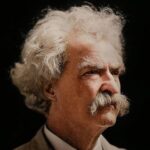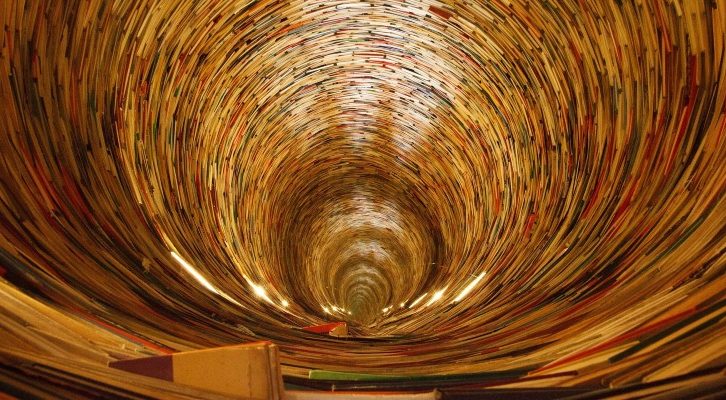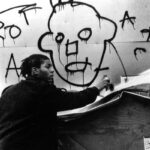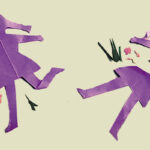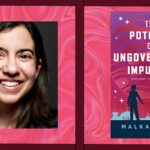Behind the Scenes at the US Open: Of Time, Age, and Politics
Timothy Denevi Wanders the Practice Courts at Flushing Meadows
I.
It’s mid-afternoon two days before the start of this year’s US Open, and all across the grounds of the Billie Jean King National Tennis Center—a sprawling 22-court expanse of statues and speakers and thin shadeless trees—the very best players in the world are practicing against one another.
On one court Juan Martin Del Potro is rallying softly from the baseline. On another Marin Cilic is hitting serves. A blue, sun-bright day: in the shadows of the grandstands you can almost convince yourself that the absurd humidity of our latest Seaboard summer might finally give way to autumn…
Still it’s pretty hot. I’m currently standing in the floor-level gallery section adjacent to practice-court three—beneath the concrete of an elevated grandstand and alongside a mesh windscreen that places me right up against the action beyond—and only a few feet away, two of the most elite women singles players on the planet are engaged in a surprisingly intense practice match.
The first is Varvara Lepchenko: a 31-year-old American tennis player who’s currently ranked 64th in the world (recently she’s been as high as 19). For the last 16 years she’s been a professional athlete—traveling the globe to participate in tennis tournaments. She’s tall and sharp-boned and incredibly strong. Her hair is pulled back into a ponytail. A left-handed power player known for the unparalleled precision of her deep, heavy groundstrokes, she’s dressed now in a trim green shirt and sky-blue cap that matches her shoes. This is her ninth time participating in the US Open. For this year’s upcoming first round match—scheduled for 11 am Monday at Arthur Ashe Stadium—she’s slated to play Garbine Muguruza, the tournament’s number-three seed. It’s a terrible stroke of luck: only the top-32 players in the draw are seeded, and as a result, anyone ranked lower runs the risk of being randomly assigned just such an unfortunate matchup.
Lepchenko’s practice partner today is Natalia Vikhlyantseva, a Russian right-hander more than a decade her junior. Together they’re playing out a single set, but with a surprising twist: as they rally through their points, each of their coaches—a pair of men who both look somewhere around 55 years of age—are standing like line judges on the expanse of the court directly behind the baseline (one is leaning against the screen through which I’m watching the action) and after every rally, both women retreat from the baseline to confer with these men about what just happened.
A sample point: Vikhlyantseva is serving. She kicks it out wide to the deuce side: a well-placed delivery that forces the lefty Lepchenko to hit a high front-footed backhand—which she strikes cleanly, with significant pace, right down the line, and now Vikhlyantseva is forced to hit her own lunging backhand, which falls just short enough for Lepchenko to run around it and smack a forehand—which is world-class—and for the next six shots, as Lepchenko strikes heavy topspin crosscourts and Vikhlyantseva scrambles further and further out wide to cover her backhand, I can’t help but notice that her Russian coach has started to shuffle his feet: a sort of awkward athletic two-step that appears to signal his anxiety in regard to what’s about to happen next.
Which is this: Varvara Lepchenko, presented with the chance to hit yet another forehand, coils on her left knee and, from an open stance, rips a breathtaking inside-out groundstroke for a winner.
A moment later the young Vikhlyantseva approaches her coach. She says something in Russian I don’t understand, and suddenly—heartily—he begins to laugh; in the next instant she does too. Of course I have no idea what they’re talking about. Though the truth is that, just then, I can’t shake the feeling that together they’ve settled on a mutual response to the problem of the point Vikhlyantseva just lost—specifically: If you keep letting her hit forehands inside the baseline you are going to die!
II.
Varvara (pronounced “VARV-ra”; her friends tend to call her “Varv”) Lepchenko became an American citizen nearly a decade ago, in 2007. She was born in 1986 in Tashkent, Uzbekistan, of Russian-Ukrainian heritage, and in 2001 she began playing professionally on the ITF Circuit, a sort of minor-league feeder for the far more elite Women’s Tennis Association, to which she graduated in 2006—the year of her first US Open appearance. At the time she was 20. After battling her way through the qualifiers she won her first round match, an amazing feat.
“The first time I just tried to get used to the atmosphere,” she explained to me a few hours after her Saturday practice. Together we were sitting in the bright lobby of her nearby hotel. “All the stars I knew were playing. It was like a miracle. I was a junior playing against Grand slam winners. Now, it’s like, okay, I feel so familiar with everything that’s happening. I belong here.”
In the 2012 she was chosen to play on the US Olympic team in London—alongside Serena and Venus Williams—and she currently lives in Allentown, Pennsylvania, commuting when she’s not out on tour to train at the same Flushing Meadows facility that hosts each year’s Open.
I first met Lepchenko when she was only 16 years old—already she was on the international tour, but during the down season she did her training at a health club in the San Francisco Bay Area that my Italian-American family has been running for generations—and I only mention it now as a way to articulate that, for more than a decade, a large number of my cousins and aunts and uncles have watched nearly every important match Lepchenko has played. Myself included: To this day I’ll never forget her three-set victory over Francesca Schiavone in the third round of the 2012 French Open—a year that saw her break into the top-20 world rankings for the first time. And there was also her memorable 2015 US Open run—when, after three straight breathtaking victories, she lost to the former world number one Victoria Azarenka in the fourth round.
All of which is to say: I don’t think is possible to overstate just how unlikely and mind-bogglingly difficult it is to work your way up to a top-20 ranking on the WTA circuit. Really, it’s like starting in the Major League Baseball All-Star Game, or finishing the season as the rebound leader in the NBA: so many thousands of other elite talents have given everything and still failed to glimpse the rarefied heights you’re currently inhabiting. And even though a discussion on the true cost and complexity of such success would take up far more room than we can afford here—especially in regards to issues like free-will versus determinism, not to mention the enduring tension between the twin causal factors of biology and environment—I do think it’s necessary to acknowledge one metaphysical question, grandiose as it might seem: that of time. As in, if you take a moment to conceptualize the physical bodies of human beings as individually ticking clocks—animal age-meters that, in their inevitable decline, register our uniquely allotted passage through the world: the time we’ve spent; the time we still have left—then what must it be like for the most uniquely coordinated people in our midst to finally come face-to-face with a universal truth the most of us were forced to deal with long ago: the reality that, from the moment you’re born, your body is fated to betray you?
To put it another way: when it comes to consider the narrative of someone like Varvara Lepchenko and her astonishing career, there’s only one opponent that really maters: time—the most ruthless villain of all.
III.
The Billie Jean King National Tennis Center, with its glass Ralph Lauren storefront and aquarium-like fan center and seemingly infinite number of Chase Bank ATM terminals, conveys a sleekly commercial vibe reminiscent of luxury car dealerships or the Las Vegas Strip’s garish escalators: the sort of style I can’t help but imagine you might someday find in the architecture of an extremely business-friendly spaceport.
On this afternoon the comparison feels especially apt: the grounds of the Center are organized around its most striking aspect: Arthur Ashe Stadium, the largest tennis-specific arena in the world, a 24,000-seat behemoth of brick and blue piping that as of 2016 includes a retractable roof—a retrofitted sheen that’s increased the spaceship feel by at least an order of ten—and even now, watching Lepchenko from behind the screen of practice-court three, I can feel that big motherfucker looming up from the corner of my vision, as if the whole thing is about to rumble itself into the sky… and take out half of the American East Coast in the process.
Earlier in the day, as I wandered the grounds in the run-up to Lepchenko’s practice session—glaring again and again at the Stadium’s monstrous 500-foot-high façade—I found myself in an outdoor corridor filled with multiple bronzed obelisks portraying images and texts: The US Open’s Court of Champions.
Each display offered a name and brief summary that, viewed in succession, began to feel like a repetitive bloc of ad copy for some ill-advised publicity campaign—something along the lines of “What Makes Great Tennis Players Great?”
Molla B. Mallory: “A tireless competitor… out-willed even the finest opponents…”
Martina Navratilova: “…fiery determination…”
Margaret Smith Court: “…was sometimes called ‘Mighty Maggie.’ Mighty indeed were her accomplishments.”
Chris Evert: “Unflappable…”
Billie Jean King: “Unrelenting fighter…Mother Freedom…”
John McEnroe: “A New Yorker.”
The broader theme is hard to miss: The difference between good tennis players and the very greatest—those lucky enough to get their action shots bronzed and displayed in a slim grotto on the far end Arthur Ashe Stadium’s endlessly bright facade—is really just a matter of ambition. Who are the best in history? Those few relentless souls who’ve overcome the limitations we all face—when confronted with the cage of a sadly human body—by propelling themselves to victory through the limitless power of their ambition.
Which isn’t entirely wrong, of course. Or even, for that mater, unique: visit Cooperstown or Canton or any other American Hall of Fame and you’ll pretty much find the same thing.
It’s just that, considering the true causality behind the unparalleled athleticism on which such historic on-court fame inherently depends, it’s hard not to find a gesture toward something as baldly simplistic as personal agency to be comically—one might even go so far as to say cosmically—absurd.
IV.
During our recent conservation, one of the first questions I asked Lepchenko had to do with pre-match preparation: how has her approach to playing in the US Open evolved over the course the last decade?
“Now I try to focus on the things I can control: How I eat, how I sleep, how I recover—everything in that sense. It’s about the rhythm. I need to be aware of how much energy I have at an event like this. I’m here to work and I need to manage my time.” She went on to talk about creating boundaries and making decisions that put her in the position to perform at the highest level possible—something she wasn’t necessarily cognizant of during her initial Open experience.
My next set of questions addressed an area of inquiry that, in retrospect, have more to do with my own personal obsessions than anything else: politics. I wanted to know what the other players on the women’s tour were saying about Donald Trump—a self-admitted sex offender—as well as the recent unrest in Charlottesville and Phoenix.
Lepchenko considered the question carefully. “I think athletes have to live in their own worlds,” she finally said. “Honestly it’s sometimes too much of a bubble—I know there are troubling things going on in the world.” She laughed quietly. “But we’re just trying to eat right, prepare for the match, trying to find the best hitting partner, trying to find the best place to practice—there’s so much involved every day. It’s hard to explain.” As she went into detail about the hour-to-hour time management a successful US Open run demands, I couldn’t help but think that one of the main things an outsider like me fails to understand about world-class athletes is the nearly unfathomable degree of time and attention they’ve learned to pay to their bodies’ most minute demands. They’re aware of their existence within their bodies in a way I’ll never be able to fully comprehend. In other words: the fact of having a body—their sensitivity to its kinetically profound possibilities and limitations—is as defining an aspect of personal identity as the actual sport they’ve spent their lives playing.
Later, we talked about the still-unresolved issue of equal pay for men and women in non Grand-Slam events (“In terms of money I think we should be paid the same because we are working just as hard”); her post-career plans (she’s currently taking online classes from a university in partnership with the WTA); and the difficulty of balancing her professional and personal life (“It’s not that hard at all!”)
Eventually our conversation turned to perhaps the biggest story of this year’s Open: the absence of Serena Williams, who’s expecting her first child, from the women’s bracket.
Williams, in my opinion one of the most brilliant athletes in the history of humankind, is a friend of Lepchenko’s; together they were teammates at the 2012 London Olympics.
“It feels kind of lonely in a way. I’m so used to seeing her and having her around in the locker room. I’m also happy for her that she’s having a baby and getting married. In life you want to achieve these kinds of things. I’m really happy for her.” After she said this she let out an endearingly self-conscious laugh, adding: “In the sense of having her as a competitor, of course the field is more open, because Serena is really hard to beat! It’s possible, but it’s so tough.”
The last time Lepchenko faced her at Flushing Meadows was in 2014: Varvara lost to her 6-3 6-3 in the third round—a match that felt even closer than its score and would turn out to be one of the only real challenges Serena would face on her way to winning a sixth tournament title.
“She’s very strong,” Lepchenko added after a pause. “She’s been on the tour for so many years, that experience—knowing when to do what—she knows it all.”
As she said this I found myself thinking back to an especially poignant moment I had experienced earlier that afternoon: I’d just left the insipid Court of Champions when I felt suddenly overcome by a rush of genuine despair that I initially attributed to a Washington Post news alert on the Texas hurricane (and our President’s naked politicizing of it)—and then to the omnipresent leer of Arthur Ashe Stadium’s 500 foot façade—before finally, sitting in the shade of a nearby grandstand, I started to pinpoint its true source: the fact that I found it deeply upsetting to visit to the grounds of the US Open in summer of 2017, one of the worst in our country’s modern history, and miss out on the chance to bask in the presence, however tangentially, of Serena Williams.
It was a ridiculous thing to be sad about, something I understood immediately, but still, he only way to describe what I was feeling is to come out and say it: I missed her. Especially this year, when the leader of our country has managed to embody the relentless ugliness that Serena’s been facing her entire career—from line judges, fans, members of the media, and fellow athletes—and with a start I realized that what I wanted most, visiting Flushing Meadows for the first time, was to witness a confrontation like the one that took place in 2009 semifinal when, responding to an insanely unfair foot-fault call—another breathtaking act of injustice to add to the long well-documented list—Serena said to the line judge: “I swear to God I’m fucking going to take this fucking ball and shove it down your fucking throat, you hear that? I swear to God!”
In other words: I’m pretty sure I’d arrived at the US Open and, turning the corner of the grandstand, genuinely believed I might somehow stumble upon the actual, literal scene of Serena Williams cursing out Donald Trump.
Insane, yes—and at the time it felt that way immediately, even as I stood there behind in the shade trying to laugh it off—but hours later, recalling it again as I talked with Varvara in the hotel lobby about Serena and Trump and gender equality and the mechanics of left-handed groundstrokes, I suddenly felt my face go hot. The shame! Who was I to expect from Williams—and, to a much lesser degree, from Lepchenko, who I’d peppered with questions on the topic—some sort of political performance… and this in addition to the athletic one they’ve been providing the Open’s spectators year after year?
Don’t get me wrong: the point I’m getting at has been made before, and in a much more elegant manner than I’m managing to do here. Still, what I’m trying to say is this: what does it mean when the fans of a sport—fans like myself who’ve spent the last year fixated on the horrific outbursts our president never fails to provide—continue to expect from certain athletes but not others the double duty of preparing their bodies for elite conflict while also finding the time and energy and effort to publicly rebut, for the benefit of an audience, the prejudices they’ve never not faced?
V.
Toward the end of our conversation, I asked Lepchenko what it was like to play at Arthur Ashe Stadium—the location for her upcoming first-round match. She thought for a moment and said, “It’s always different. You can get shadows on the court. Sun. Wind. Sometimes in the morning it’s cooler. In the afternoons hotter, the ball is flying more. Windy in the evening. You have to move your feet to get better timing. There’re a lot of factors involved.” When I brought up the recent successes of her opponent, the number-three-seeded Garbine Muguruza, she shrugged and said, “I’ve beat her before and I’ve lost to her and I’ve beat her.”
It’s a statement filled with confidence, and why not? Lepchenko’s playing well. To pull off an early upset she’ll need to execute a complete game: serve aggressively and accurately, keep her unforced errors down on the backhand side, and hit her elite forehand with abandon. A tall order, yes, but not as outlandish as you might think: when Varvara Lepchenko is playing well she can beat any woman in the world. Which is perhaps the best definition of elite I can offer. Think about it: of how many other people on this earth can such a thing be honestly said?
After our interview—after I’d said goodbye and wished her well—I recalled a final detail of her afternoon session with Natalia Vikhlyantseva: a moment from the very end of their practice set.
It goes like this:
Vikhlyantseva is serving on the deuce side and hits a beautiful flat first serve right down the center. Varvara stutter steps and lunges for it with her forehand—her stance is open and, amazingly, she gets herself into position for a full swing—but instead of catching the ball on the strings she frames it straight up into the air. The subsequent shot rises much higher than a lob—in fact, it’s the highest ball I’ve ever seen hit on a tennis court—and for an instant it appears that it might actually fall back down from the blue heights of the sky and land in. And now Vikhlyantseva is sprinting toward the net, watching the trajectory as she cocks her racquet back for an overhead.
But over on the other side of the court, Varv hasn’t moved from the baseline. She’s still in her wide stance, squinting as the ball reaches its improbable apogee and finally begins to descend. What’s more, her lips are moving; she’s saying something in Russian—saying it to the ball—a string of words I can’t really hear. Whether she means them as a curse or to coax I’m not sure.
Soon enough the ball will land. But on which side of the net? Instead, consider this: when all is said and done, the strange sun-scraping shot will turn out to be Lepchenko’s only mishit of the day.












